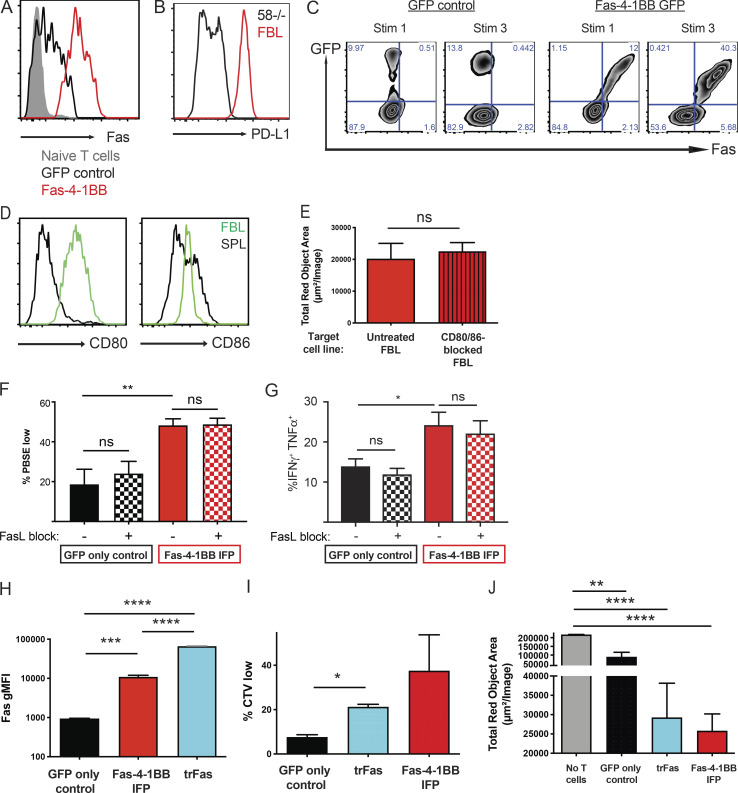Figure S2.
Fas-4-1BB expression enhances function of transduced T cells. For A–E, engineered TCRgag T cells were generated as described in Fig. 2. (A) Expression of Fas on naïve (gray), GFP-only (black), or Fas-4-1BB with GFP (red) TCRgag T cells as detected by anti-Fas antibody and flow cytometry. (B) Expression of PD-L1 on 58−/− and FBL murine cell lines as detected by specific antibody staining and flow cytometry. (C) Enrichment of Fas-4-1BB T cells after in vitro restimulation. A mixed population of transduced (GFP+) and non-transduced (GFP−) TCRgag T cells was restimulated with irradiated FasL+ FBL and splenocytes, and the proportion of GFP+ TCRgag T cells was quantified by flow cytometry. (D) Expression of CD80 and CD86 in FBL (green) and naïve C57BL/6 splenocytes (black) as detected by flow cytometry. SPL, spleen. (E) NucLight Red+ FBL were untreated or treated with blocking anti-CD80 and -CD86 antibodies and used to stimulate Fas-4-1BB–transduced T cells every 24 h for three stimulations. 24 h following the last stimulation, the remaining FBL were quantified by IncuCyte analysis. (F and G) Transduced P14 T cells were generated as described in Fig. 1. (F) Quantification of PBSE dilution of GFP- or IFP-engineered P14 T cells 7 d after stimulation with peptidegp33-pulsed splenocytes with or without FasL-blocking antibody (150 ng/ml). Average of three independent experiments. **, P < 0.01; one-way ANOVA for multiple comparisons. (G) Cytokine production of engineered P14 T cells after co-culture with peptidegp33 (1 μg/ml), with or without blocking anti-FasL antibody (150 ng/ml), for 5 h in the presence of GolgiPlug (BD Biosciences). Culture conditions are indicated below the graph. Cells were fixed, permeabilized, stained for intracellular cytokines, and assessed by flow cytometry. Average of three independent experiments. ns, not significant; *, P< 0.05; one-way ANOVA for multiple comparisons. (H–J) Engineered TCRgag T cells were generated as described in Fig. 2. (H) Geometric MFI (gMFI) of Fas expression in engineered T cells. (I) Proliferation of TCRgag T cells (100,000 cells) expressing GFP empty vector control (black), trFas (blue), or Fas-4-1BB (red) as measured by cell trace violet (CTV) dilution by flow cytometry after stimulation with 6,250 FBL for 7 d. (J) SKO assay final time point quantification of tumor cells. NucLight Red+ FBL were co-cultured with TCRgag T cells transduced to express GFP only, trFas, or Fas-4-1BB. NucLight Red+ FBL were re-added every 24 h for a total of three stimulations/exposures. 24 h following the last stimulation, the remaining FBL were quantified by IncuCyte analysis. Data are representative of two (A–D) experiments or represent the mean of four (E) or three (F–J) experiments. ns, not significant; *, P < 0.05; **, P< 0.01; ***, P< 0.001; ****, P< 0.0001; t test or one-way ANOVA (H). Error bars indicate SEM. FBL, Friend murine virus (F-MuLV)–induced leukemia.

